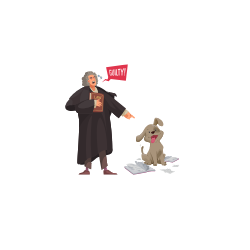Dog behaviorists have seen it all—from the overenthusiastic tail wags to the infamous “guilty” look that usually follows a mysteriously empty plate. While dogs may not speak our language, they communicate volumes through their body language. Understanding what your pup is trying to tell you can improve your bond, prevent misunderstandings, and maybe even save your favorite shoes from becoming chew toys. Let’s break down the science of dog communication, one wag at a time.
The Tail Tale: Not All Wags Are Created Equal
Contrary to popular belief, a wagging tail doesn’t always mean a happy dog. The direction, speed, and height of the wag all provide clues about their mood.
- Fast and Loose Wag? Pure joy. Your dog is probably thrilled to see you, or at least your snack.
- Stiff, Slow Wag? Proceed with caution. This could be uncertainty or even a warning.
- Tail Tucked Between the Legs? Fear, anxiety, or possibly guilt over that shredded couch cushion.
- Helicopter Wag? Jackpot! You’re their favorite human.
Ears: Nature’s Mood Barometers
Dogs’ ears are like emotional antennae, constantly adjusting to match their mood.
- Perked Up & Forward? Alert and engaged—possibly waiting for you to say “walk.”
- Pinned Back? Nervous or submissive. Could also mean “Please don’t be mad about the chewed-up shoe.”
- Relaxed and Neutral? A content pup, living their best life.
The Eyes Have It: Puppy Dog Stares & Side-Eye Sass
A dog’s eyes are windows to their emotions, and they’re constantly giving us signals.
- Soft, Blinking Eyes? Trust and affection. This is the dog version of a warm hug.
- Hard Stare? A challenge. Time to defuse tension before things escalate.
- Whale Eye (when you can see the whites)? Anxiety or discomfort. It usually means, “I don’t like this situation, but I’m trying to be polite.”
Mouth Movements: Smiles, Yawns & Zoomie Triggers
Dogs express a lot with their mouths, and not just by barking.
- Relaxed, Slightly Open Mouth? A happy, content pup enjoying life.
- Lips Pulled Back, Showing Teeth? This could be aggression—or just an awkward smile. Context is key.
- Yawning? Not necessarily tired! Dogs yawn when they’re stressed or trying to calm themselves.
- Licking Lips? Nervousness or anticipation—like when you unwrap a cheese stick.
Full-Body Signals: When in Doubt, Read the Whole Dog
Dogs rarely express emotions with just one signal. Looking at the full picture helps interpret their true feelings.
- Play Bow (Front Down, Butt Up)? An invitation to play—and probably a zoomie warning.
- Frozen Stance? This means serious business. If a dog suddenly goes still, it’s assessing a situation before acting.
- Rolling Over Belly-Up? Either a request for belly rubs or a sign of deep submission.
Final Thoughts: Listen With Your Eyes
Your dog is constantly “talking” to you—it’s just a matter of tuning in. The better you understand their body language, the stronger your bond will be. So next time your pup gives you side-eye or wags their tail like a helicopter, you’ll know exactly what they’re saying. And hopefully, that means more belly rubs and fewer chewed-up shoes!


Leave a Reply